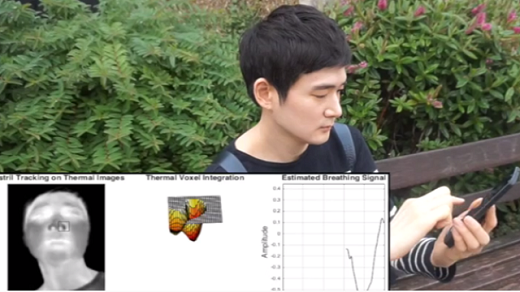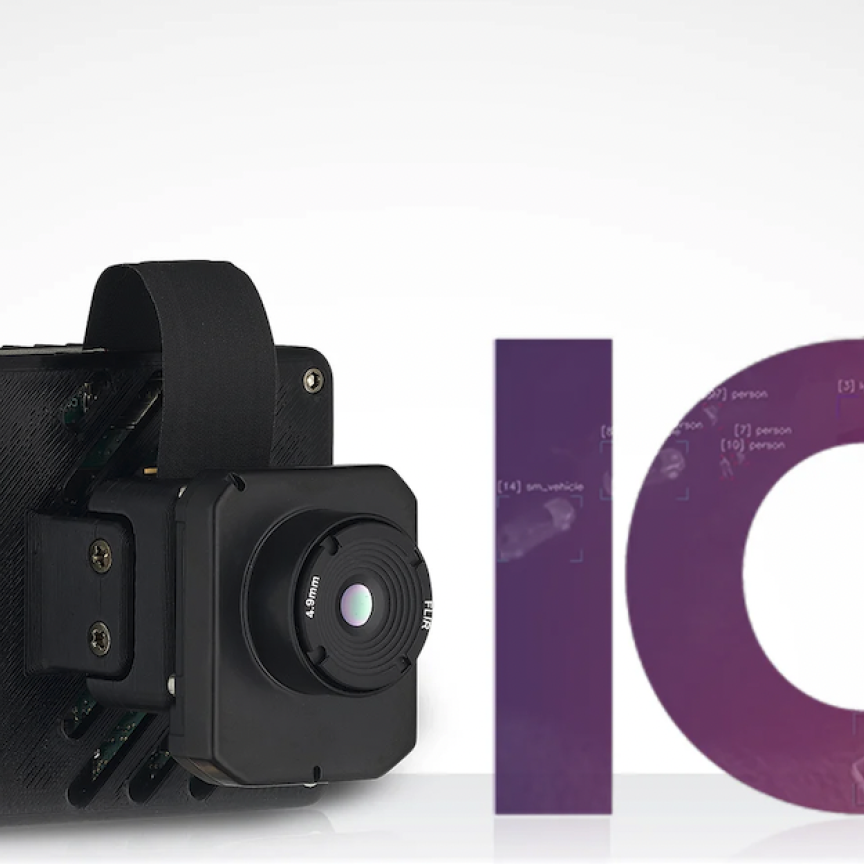Researchers at University College London have developed a new piece of software that enables the use of low-cost thermal cameras attached to mobile phones to track the rate of a person’s breathing.

The new algorithm uses a phone-mounted thermal camera to monitor the movement and temperature changes of the nostrils in order to measure a person's breathing. (Credit: Youngjun Cho, University College London)
Described in Biomedical Optics Express, the portable software-camera system analyses body movement and temperature changes to monitor respiration, and could be used to observe breathing problems in elderly people living alone, potential sleep apnea sufferers, or newborn babies.
Larger, more expensive thermal imaging systems have been used in the past to measure breathing by monitoring temperature changes inside the nostrils under controlled settings, according to Youngjun Cho, first author of the paper. However, thanks to the ongoing decrease in the price and size of thermal devices – a small thermal camera for a mobile phone can be purchased for around $200 – a range of portable alternatives is now available.
‘We wanted to use the new portable systems to do the same thing [as the larger systems] by creating a smart phone-based respiratory tracking method that could be used in almost any environment or activity,’ Cho commented.
The researchers’ algorithms therefore had to be developed to compensate for ambient temperature changes and accurately track the nostrils of a moving person. The resulting product improved on previous technologies by analysing the nostril area as a 3D surface rather than a set of 2D pixels, allowing more refined measurements of breathing to be taken.
‘The algorithms showed significantly better performance in tracking the nostril area than other state-of-the-art methods [involving multiple sensors],’ remarked Cho. ‘In terms of estimating the breathing rate, the tests … showed the best results when compared with the latest algorithms.’
Although traditional video cameras can be used to track breathing, they don’t work well in low-light situations, according to the researchers, and can cause privacy concerns when used for monitoring in nursing homes, for example.
‘Thermal cameras can detect breathing at night and during the day without requiring the person to wear any type of sensor,’ said Cho. ‘Compared to a traditional video camera, a thermal camera is more private because it is more difficult to identify the person.’
In order to test the portable system in mobile situations, the thermal camera was placed 20 to 30cm away from a person’s face using a rig that attached the camera to a hat. The resulting data was comparable to those of a traditional breathing belt sensor, but for mobile situations the researcher’s system proved to be more stable, as breathing belt sensors can often become loose. The new system could therefore potentially be used to optimise an athlete’s performance in the future by providing more reliable and accurate feedback on breathing patterns during exercise.
While the current version of the software doesn’t estimate the breathing rate in real time, the researchers intend to incorporate this capability in the future and test their algorithms in more real-life situations.
Another potential application of the new system is the inferring of a person’s mental load or stress through automatic respiratory analysis, for example a camera on a personal computer detecting subtle breathing irregularities associated with pain or stress. The researchers tested this by using their thermal imaging software to track the breathing of people who were free to move around while performing various types of tasks, and the results aligned well with findings from studies that used much more sophisticated equipment. The new system could therefore one day assist tools that help technology users relax and regulate their breathing.

